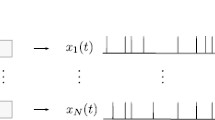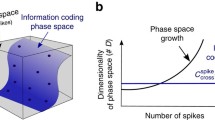Abstract
The assessment of the variability of neuronal spike timing is fundamental to gain understanding of latency coding. Based on recent mathematical results, we investigate theoretically the impact of channel noise on latency variability. For large numbers of ion channels, we derive the asymptotic distribution of latency, together with an explicit expression for its variance. Consequences in terms of information processing are studied with Fisher information in the Morris–Lecar model. A competition between sensitivity to input and precision is responsible for favoring two distinct regimes of latencies.
Similar content being viewed by others
References
Adair RK (2003) Noise and stochastic resonance in voltage-gated ion channels. Biosystems 100(21): 12099–12104
Arhem P, Blomberg C (2007) Ion channel density and threshold dynamics of repetitive firing in a cortical neuron model. Biosystems 89(1–3): 117–125
Berry MJ, Warland DK, Meister M (1997) The structure and precision of retinal spike trains. Proc Natl Acad Sci USA 94: 5411–5416
Chase SM, Young ED (2008) Cues for sound localization are encoded in multiple aspects of spike trains in the inferior colliculus. J Neurophysiol 99: 1672–1682
Chen Y, Yu L, Qin SM (2008) Detection of subthreshold pulses in neurons with channel noise. Phys Rev E 78: 51909
Chow CC, White JA (1996) Spontaneous action potentials due to channel fluctuations. Biophys J 71(6): 3013–3021
Colbert CM, Johnston D (1996) Axonal action-potential initiation and Na+ channel densities in the soma and axon initial segment of subicular pyramidal neurons. J. Neurosci 16(21): 6676–6686
Colbert CM, Pan P (2002) Ion channel properties underlying axonal action potential initiation in pyramidal neurons. Nat Neurosci 5(6): 533–538
Ethier SN, Kurtz TG (1986) Markov processes, characterization and convergence. John Wiley and Sons, Inc
Furukawa S, Middlebrooks JC (2002) Cortical representation of auditory space: information-bearing features of spike patterns. J Neurophysiol 87: 1749–1762
Gillespie DT (1977) Exact stochastic simulation of coupled chemical reactions. J Phys Chem 81(25): 2340–2361
Gollisch T, Meister M (2008) Rapid neural coding in the retina with relative spike latencies. Science 319(1): 1108–1111
Guyonneau R, VanRullen R, Thorpe SJ (2005) Spike times make sense. Trends Neurosci 28(1): 1–4
Heil P (2004) First-spike latency of auditory neurons revisited. Curr Opin Neurobiol 14: 461–467
Hille B (2001) Ion channels of excitable membranes. Sinauer, Sunderland, MA
Hodgkin AL (1948) The local electric changes associated with repetitive action in a non-medullated axon. J Physiol 107: 165–181
Izhikevich EM (2007) Dynamical systems in neuroscience: the geometry of excitability and bursting. In: Computational neuroscience. MIT Press
Jenison RL, Reale RA (2003) Likelihood approaches to sensory coding in auditory cortex. Netw Comput Neural Syst 14: 83–102
Johansson RS, Birznieks I (2004) First spikes in ensembles of human tactile afferents code complex spatial fingertip events. Nat Neurosci 7: 170–177
Kiani R, Esteky H, Tanaka K (2005) Differences in onset latency of macaque inferotemporal neural responses to primate and non-primate faces. J Neurophysiol 94(2): 1587–1596
Kjaer TW, Gawne TJ, Richmond BJ (1996) Latency: another potential code for feature binding in striate cortex. J Neurophysiol 76(2): 1356–1360
Krishna BS (2002) A unified mechanism for spontaneous-rate and first-spike timing in the auditory nerve. J Comput Neurosci 13: 71–91
Lansky P, Musila M (1991) Variable initial depolarization in Stein’s neuronal model with synaptic reversal potentials. Biol Cybern 64: 285–291
Liberman MC (1978) Auditory-nerve response from cats raised in a low-noise chamber. J Acoust Soc Am 63(2): 442–455
Manns D, Westecker ME (1983) Antidromic activation of spikes with bimodal and trimodal latencies in the olfactory bulb of rabbits. Brain Res 288(1–2): 119–130
Mormann F, Kornblith S, Quian Quiroga R, Kraskov A, Cerf M, Fried I, Koch C (2008) Latency and selectivity of single neurons indicate hierarchical processing in the human medial temporal lobe. J Neurosci 28(36): 8865–8872
Morris C, Lecar H (1981) Voltage oscillations in the barnacle giant muscle fiber. Biophys J 35(1): 193–213
Oser M, Uzuntarla M (2008) Effects of the network structure and coupling strength on the noise-induced response delay of a neuronal network. Phys Lett A 372: 4603–4609
Pakdaman K, Thieullen M, Wainrib G (2009) Fluid limit theorems for stochastic hybrid systems with application to neuron models. J Appl Probab (accepted)
Pankratova EV, Polovinkin AV, Mosekilde E (2005) Resonant activation in a stochastic Hodgkin-Huxley model: Interplay between noise and suprathreshold driving effects. Eur Phys J B 45: 391–397
Panzeri S, Petersen RS, Schultz SR, Lebedev M, Diamond ME (2001) The role of spike timing in the coding of stimulus location in rat somatosensory cortex. Neuron 29: 769–777
Reulen JPH (1984) Latency of visually evoked saccadic eye movements. Biol Cybern 50(4): 251–262
Rinzel J, Ermentrout GB (1989) Analysis of neural excitability and oscillations. In: Methods in neuronal modeling: from synapses to networks, MIT Press, Cambridge, MA, pp 135–169
Rowat P (2007) Interspike interval statistics in the stochastic Hodgkin–Huxley model: coexistence of gamma frequency bursts and highly irregular firing. Neural Comput 19(5): 1215
Ruggero MA (1992) Physiology and coding of sound in the auditory nerve. In: Popper AN, Fay RR (eds) The mammalian auditory pathway. Springer-Verlag, New York, pp 34–93
Schneidman E, Freedman B, Segev I (1998) Ion channel stochasticity may be critical in determining the reliability and precision of spike timing. Neural Comput 10(7): 1679–1703
Shuai JW, Jung P (2003) Optimal ion channel clustering for intracellular calcium signaling. Proc Natl Acad Sci 100(2): 506–512
Skaugen E, Walloe L (1979) Firing behavior in a stochastic nerve membrane model based upon the Hodgkin–Huxley equations. Acta Physiol Scand 107(4): 343–363
Tanabe S, Pakdaman K (2001) Noise-induced transitions in excitable neuron models. Biol Cybern 85: 269–280
Thorpe S, Fize D, Marlot C (1996) Speed of processing in the human visual system. Nature 381(6582): 520–522
Tuckwell HC, Wan FYM (2005) Time to first spike in stochastic hodgkinhuxley systems. Physica A 351(2–4): 427–438
van Rossum MCW (2001) The transient precision of integrate and fire neurons: effect of background activity and noise. J Comput Neurosci 10: 303–311
van Rossum MCW, O’Brien BJ, Smith RG (2003) Effects of noise on the spike timing precision of retinal ganglion cells. J Neurophysiol 89: 2406–2419
Van Rullen R (2003) Visual saliency and spike timing in the ventral visual pathway. J Physiol Paris 97(2-3): 365–377
Verveen AA, Derksen HE (1965) Fluctuations in membrane potential of axons and the problem of coding. Biol Cybern 2(4): 153–160
Wollner DA, Catterall WA (1986) Localization of sodium channels in axon hillocks and initial segments of retinal ganglion cells. Proc Natl Acad Sci USA 83(21): 8424–8428
Author information
Authors and Affiliations
Corresponding author
Additional information
An erratum to this article can be found online at http://dx.doi.org/10.1007/s00422-011-0462-6
Rights and permissions
About this article
Cite this article
Gilles, W., Michèle, T. & Khashayar, P. Intrinsic variability of latency to first-spike. Biol Cybern 103, 43–56 (2010). https://doi.org/10.1007/s00422-010-0384-8
Received:
Accepted:
Published:
Issue Date:
DOI: https://doi.org/10.1007/s00422-010-0384-8




